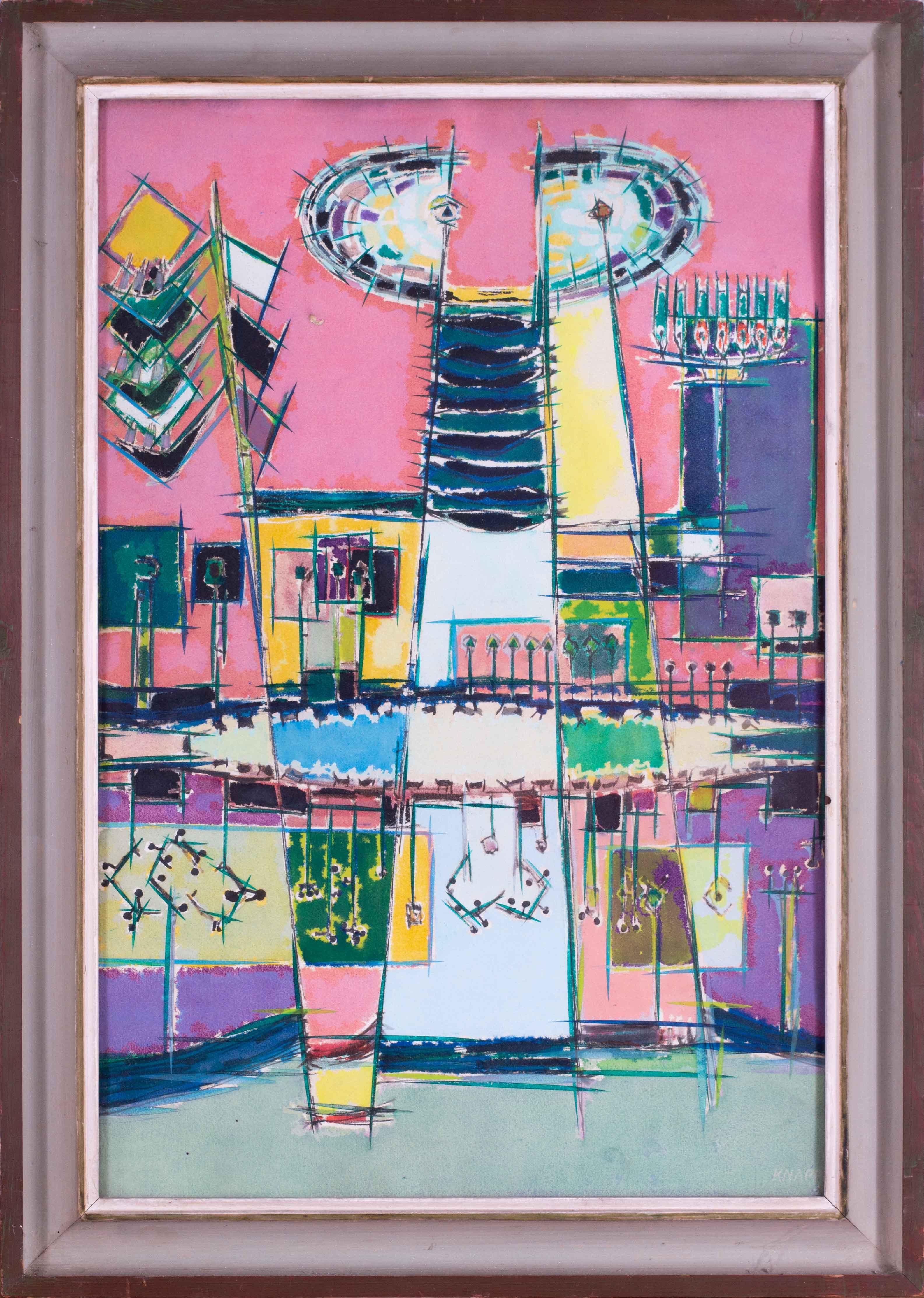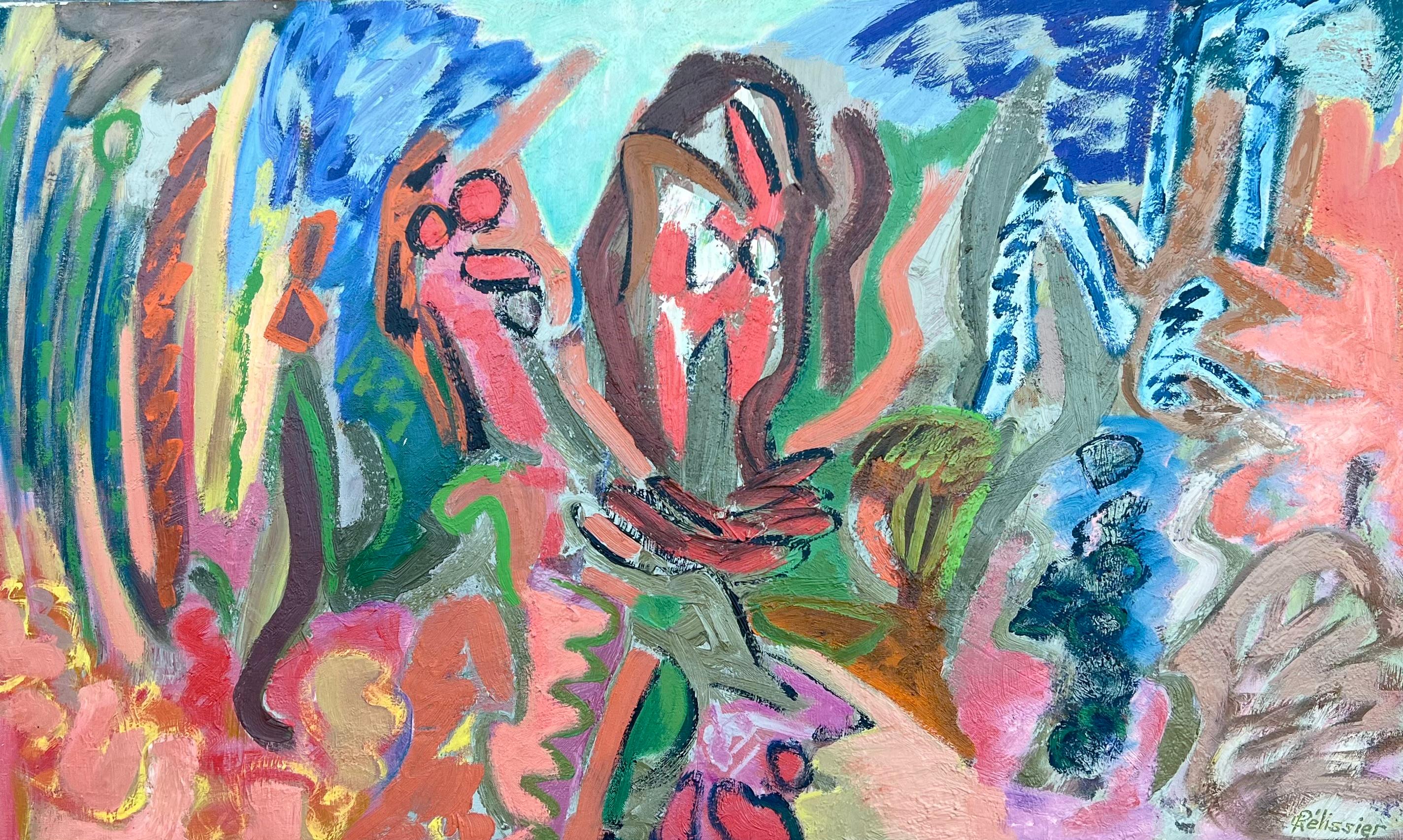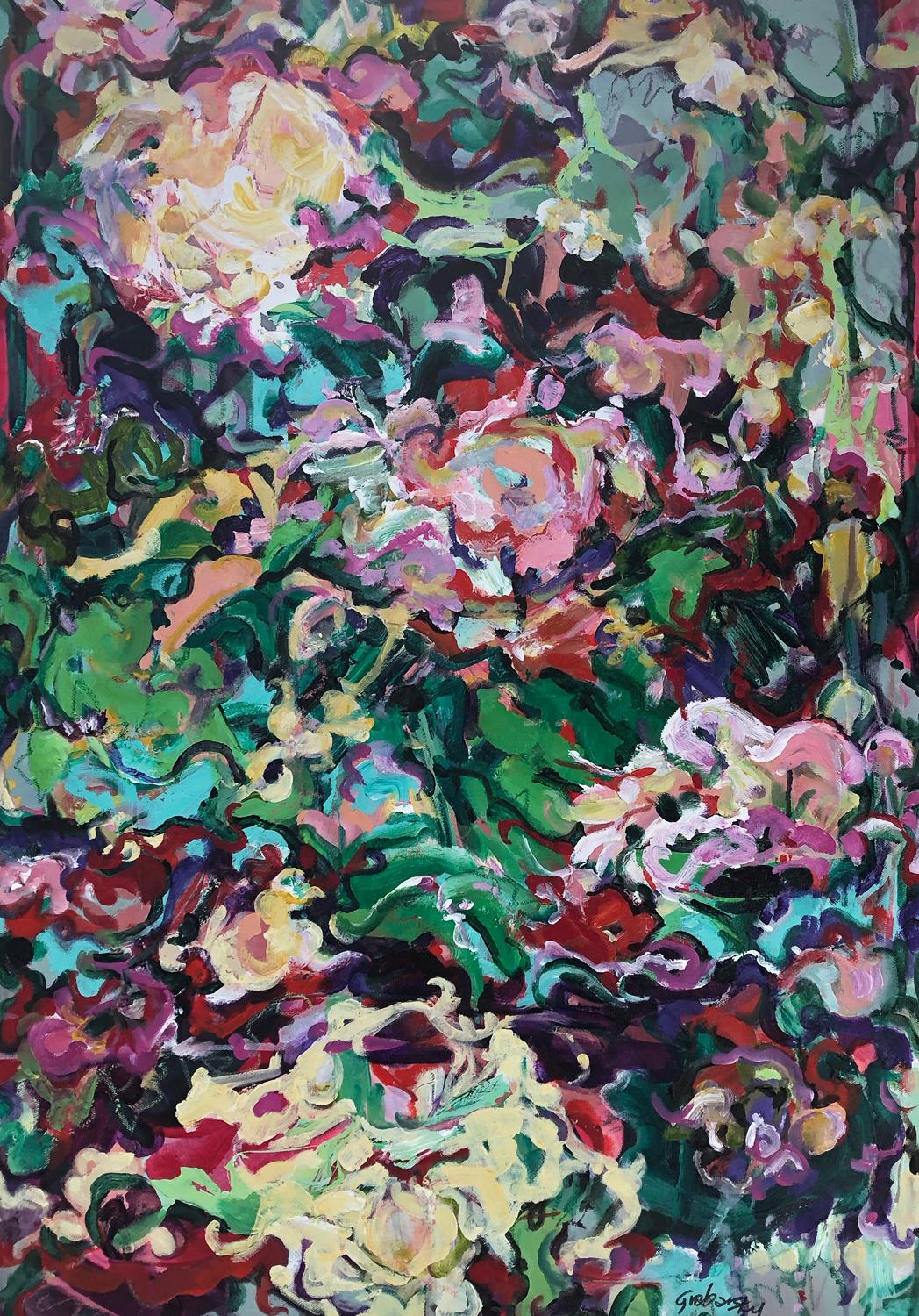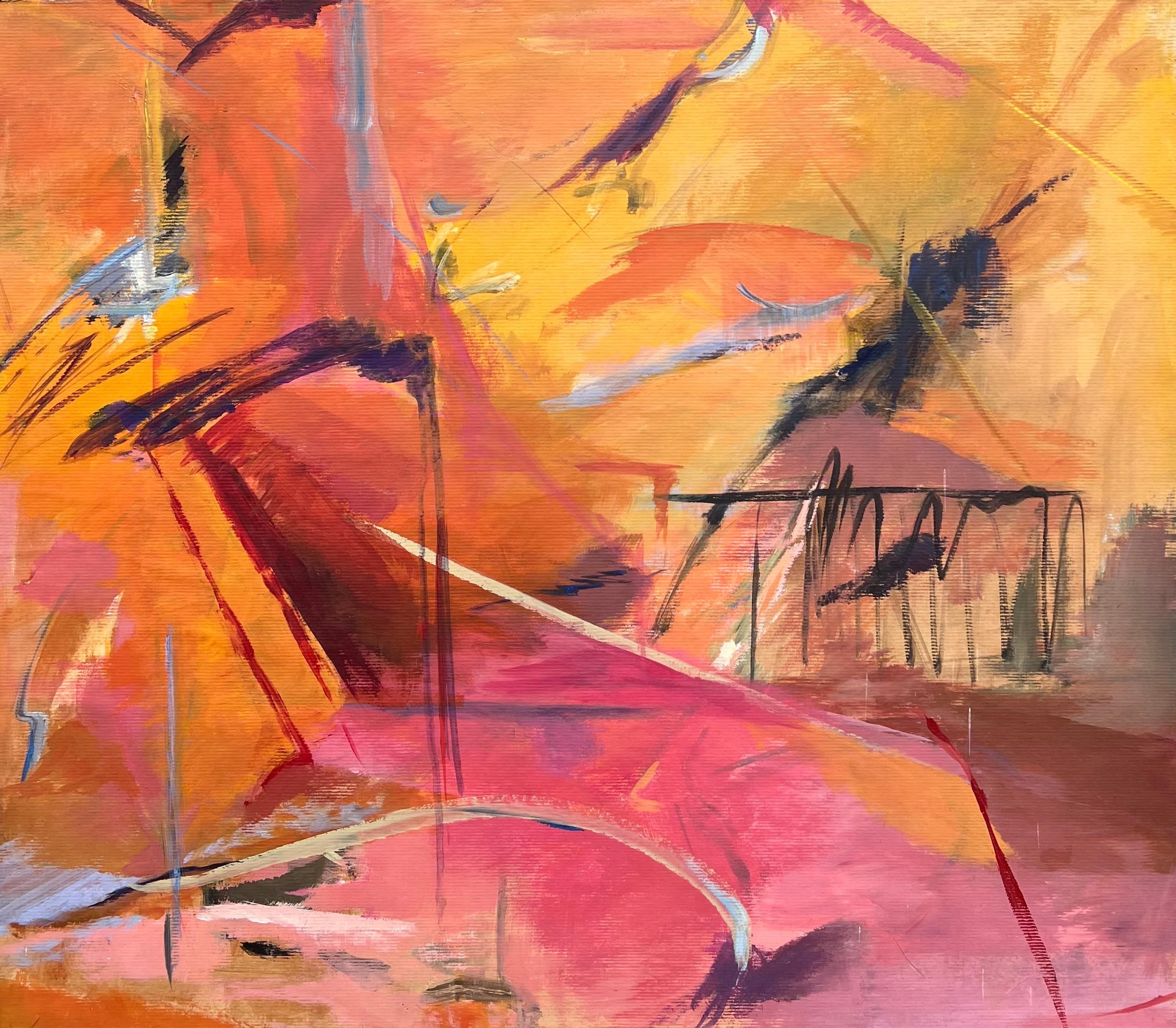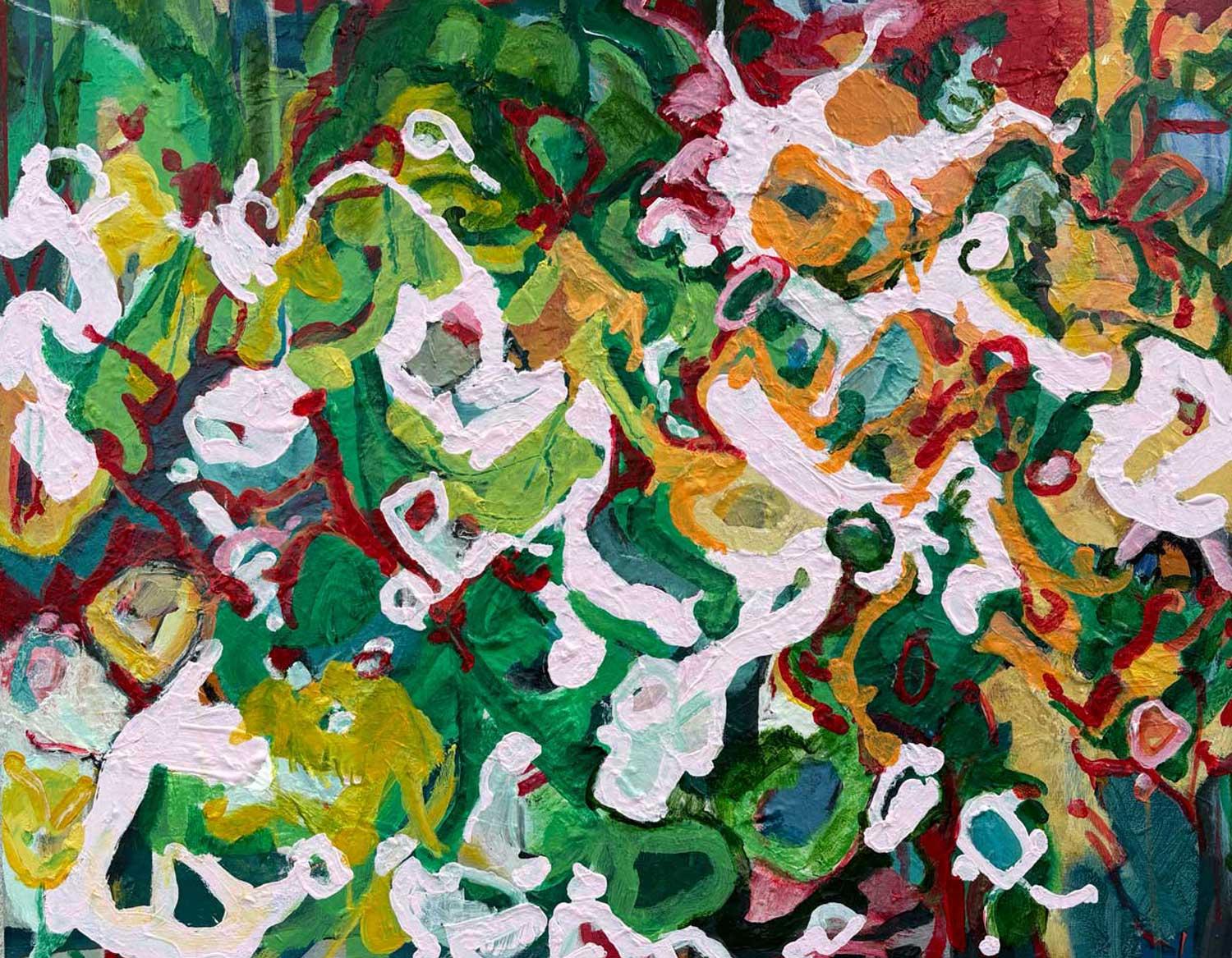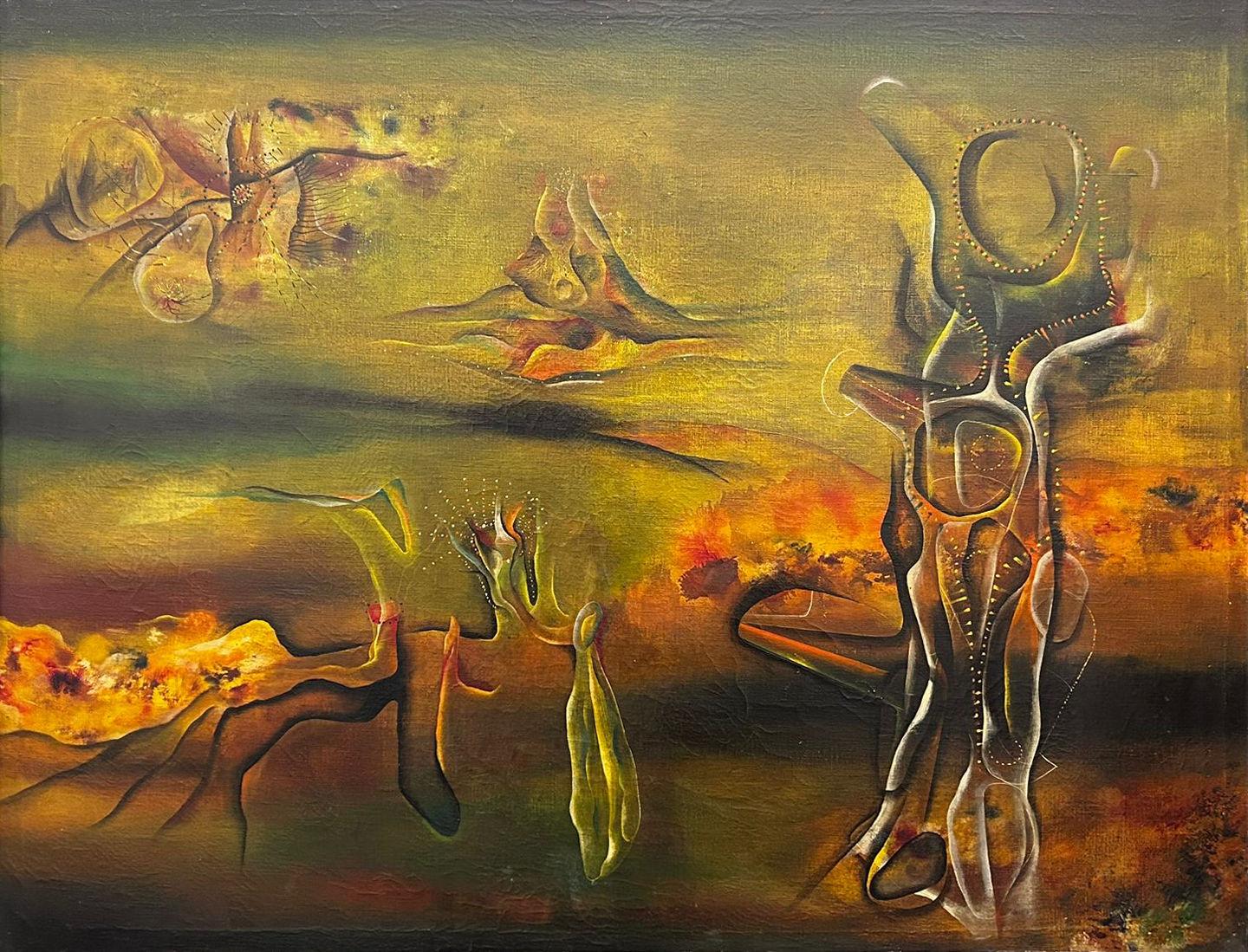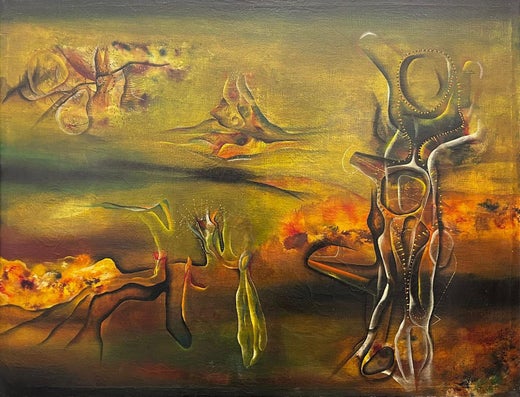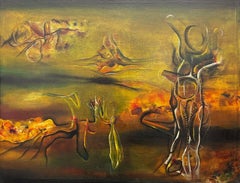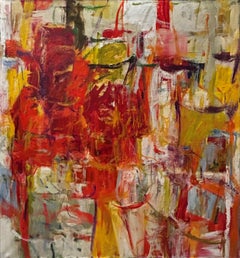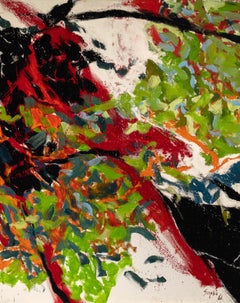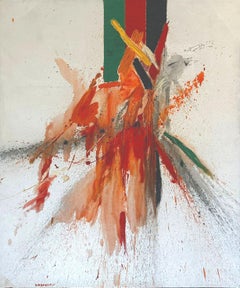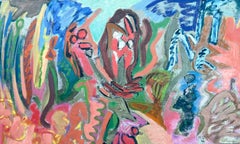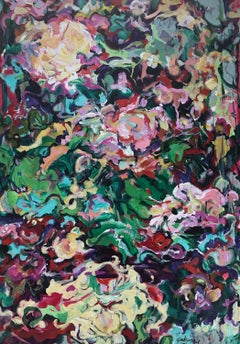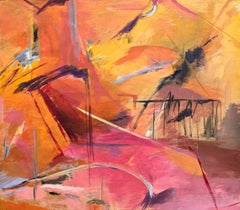Items Similar to "Pink Garden" Gerome Kamrowski, American Surrealist 1947 Expressive Abstraction
Want more images or videos?
Request additional images or videos from the seller
1 of 7
Gerome Kamrowski"Pink Garden" Gerome Kamrowski, American Surrealist 1947 Expressive Abstraction1947
1947
Price Upon Request
Price Upon Request
Price Upon Request
Price Upon Request
Price Upon Request
Price Upon Request
Price Upon Request
Price Upon Request
Price Upon Request
Price Upon Request
About the Item
Gerome Kamrowski
Pink Garden, 1947
Signed lower left
Watercolor on paper
22 x 30 inches
Gerome Kamrowski was born in Warren, Minnesota, on January 19, 1914. In 1932 he enrolled in the Saint Paul School of Art (now Minnesota Museum of American Art - MMAA), where he studied with Leroy Turner, and Cameron Booth. Both Turner and Booth had been students of Hans Hofmann, and were also associated with the Abstraction-Création group in Paris. It was from these peers that Kamrowski was introduced to a "kind of expressionist cubism." In 1933 Kamrowski was awarded a scholarship to the Art Students League, where he would study in New York under Hans Hofmann. Unfortunately, immigration problems had prevented Hofmann from assuming his post. Nevertheless, Kamrowski decided to remain in New York for a short time, to attend classes taught by George Grosz. After a few weeks, he returned to St. Paul, and found a position in the mural painting division of the Minnesota FAP/WPA (Works Progress Administration). In 1936 he contributed “Synthetic Cubist Style” frescoes in the Northrup Auditorium of the University of Minnesota.
In 1937 Kamrowski went to Chicago to study under László Moholy-Nagy and Alexander Archipenko at the New Bauhaus (now Illinois Institute of Technology's Institute of Design). There he was exposed to new and interesting ideas regarding the role of nature in art and the "geometric basis of natural form".
In 1938 Kamrowski received a Guggenheim fellowship to attend Hans Hofmann's summer school in Provincetown, Massachusetts. He then relocated to New York where he met William Baziotes. Together they shared a fascination in Surrealist automatic writing, and both artists explored its possibilities in their paintings. Kamrowski was particularly drawn to Surrealism's fundamental appeal of intuition over intellect. He was interested seeking a process that "binds all things together...a kind of cosmic rhythm".
Throughout the late 1930s and early 1940s while living in New York, Kamrowski became an integral part of the emerging surrealists. In 1942, the artist Roberto Matta attempted to form a group of artists to investigate new applications for Surrealist methods. He invited Kamrowski, along with William Baziotes, Jackson Pollock, Peter Busa, and Robert Motherwell to join. Like Kamrowski, the others were more interested in process than in subject matter—the foundation of Matta's art—and the group soon dissolved. But no matter how short lived the collaboration was, this group was the kernel of the open-ended movement that was referred to as abstract surrealism and would over time prove to be the beginnings of abstract expressionism.
It was during this time, the winter of 1939/1940, that an amazing collaboration was made. Kamrowski and two of his contemporaries, William Baziotes and Jackson Pollock, came together and began to paint. The description of this historic event is described as follows in "Pollock" by Ellen G. Landau: "For a number of years, Kamrowski had been involved with Surrealist image-coaxing techniques. In a letter to B.H. Friedman, Kamrowski recalled that one day he, Pollock, and Baziotes were fooling around' with quart-cans of lacquer paint. Baziotes asked if he could use some 'to show Pollock how the paint could be spun around.' He then looked around the room for something to work on, and a canvas that Kamrowski had 'been pouring paint on and was not going well' was handy, so Baziotes began to throw and drip' white paint on it. He next gave the dripping palette knife to Jackson, who with his intense concentration' started flipping the paint with abandon. ' According to Kamrowski, after all had a chance to play, Baziotes identified the spiral forms he had created as 'birds' nests, ' but Pollock refused to interpret his spots." This painting was a pivotal work, showing the transition from, and fusion of, Surrealism to Action Painting and Abstract Expressionism.
In 1947, Kamrowski was invited to the Surrealist Exhibition in Paris by Surrealist leader André Breton. Breton said of him, "Of all the young painters whose evolution I have been able to follow in New York during the last years of the war, Gerome Kamrowski is the one who has impressed me far the most by reason of the "quality" and sustained character of his research. Among all the newcomers there, he was the only one...tunnelling in a new direction..."
In the 1940s Kamrowski relocated to Ann Arbor, Michigan in order to teach at the University of Michigan School of Art. It was a career that would span thirty-eight years, and would encourage countless others to push their artistic boundaries. Professor Jon Rush, at the University's School of Art and Design, stated: "As a teacher, Professor Kamrowski admonished his students to experiment and push the boundaries of their art. He urged them to be unafraid of failure and consider it a natural part of the creative process," and says "Above all, he stressed the importance of finding one's own path and that it would take hard work and dedication to achieve that. He was a natural teacher who related well to students because he himself never stopped being one."
Teaching became a second passion. Over the years, Kamrowski's energy and drive never faltered, and his style continued to evolve dynamically from the abstract intellectual exercises of the past to colorful 3-D pieces often made of glass, cement, and random found objects. He worked every day and exhibited steadily in Michigan and elsewhere. He once said, "Michigan has been good to me, don't misunderstand me, but on the other hand I have a certain amount of contempt for it."
He cited architects Antoni Gaudi and Simon Rodia as inspirations.
- Creator:Gerome Kamrowski (1914-2004, American)
- Creation Year:1947
- Dimensions:Height: 35 in (88.9 cm)Width: 43 in (109.22 cm)
- Medium:
- Movement & Style:
- Period:
- Condition:
- Gallery Location:New York, NY
- Reference Number:1stDibs: LU1841215159502
Gerome Kamrowski
Gerome Kamrowski was born in Warren, Minnesota, on January 19, 1914. In 1933 Kamrowski was awarded a scholarship to the Art Students League, where he would study in New York under Hans Hofmann. Kamrowski decided to remain in New York for a short time, to attend classes taught by George Grosz. After a few weeks, he returned to St. Paul, and found a position in the mural painting division of the Minnesota WPA. In 1937 Kamrowski went to Chicago to study under László Moholy-Nagy and Alexander Archipenko at the New Bauhaus. There he was exposed to new and interesting ideas regarding the role of nature in art and the "geometric basis of natural form". In 1938 Kamrowski received a Guggenheim fellowship to attend Hans Hofmann's summer school in Provincetown, Massachusetts. He then relocated to New York where he met William Baziotes. Together they shared a fascination in Surrealist automatic writing, and both artists explored its possibilities in their paintings. Kamrowski was particularly drawn to Surrealism's fundamental appeal of intuition over intellect. He was interested seeking a process that "binds all things together...a kind of cosmic rhythm". Throughout the late 1930s and early 1940s while living in New York, Kamrowski became an integral part of the emerging surrealists. In 1942, the artist Roberto Matta attempted to form a group of artists to investigate new applications for Surrealist methods. He invited Kamrowski, along with William Baziotes, Jackson Pollock, Peter Busa, and Robert Motherwell to join. No matter how short lived the collaboration was, this group was the kernel of the open-ended movement that was referred to as abstract surrealism and would over time prove to be the beginnings of abstract expressionism. It was during this time, the winter of 1939/1940, that an amazing collaboration was made. Kamrowski and two of his contemporaries, Baziotes and Pollock, came together and began to paint. This painting was a pivotal work, showing the transition from, and fusion of, Surrealism to Action Painting and Abstract Expressionism. In 1947, Kamrowski was invited to the Surrealist Exhibition in Paris by Surrealist leader André Breton. Breton said of him, "Of all the young painters whose evolution I have been able to follow in New York during the last years of the war, Kamrowski is the one who has impressed me far the most by reason of the "quality" and sustained character of his research." In the 1940s Kamrowski relocated to Ann Arbor, Michigan in order to teach at the University of Michigan School of Art. It was a career that would span 38 years, and would encourage countless others to push their artistic boundaries. Teaching became a second passion. Over the years, Kamrowski's energy and drive never faltered, and his style continued to evolve dynamically from the abstract intellectual exercises of the past to colorful 3D pieces often made of glass, cement, and found objects. He worked every day and exhibited steadily in Michigan and elsewhere.
About the Seller
5.0
Platinum Seller
Premium sellers with a 4.7+ rating and 24-hour response times
Established in 2022
1stDibs seller since 2022
118 sales on 1stDibs
Typical response time: <1 hour
- ShippingRetrieving quote...Shipping from: New York, NY
- Return Policy
Authenticity Guarantee
In the unlikely event there’s an issue with an item’s authenticity, contact us within 1 year for a full refund. DetailsMoney-Back Guarantee
If your item is not as described, is damaged in transit, or does not arrive, contact us within 7 days for a full refund. Details24-Hour Cancellation
You have a 24-hour grace period in which to reconsider your purchase, with no questions asked.Vetted Professional Sellers
Our world-class sellers must adhere to strict standards for service and quality, maintaining the integrity of our listings.Price-Match Guarantee
If you find that a seller listed the same item for a lower price elsewhere, we’ll match it.Trusted Global Delivery
Our best-in-class carrier network provides specialized shipping options worldwide, including custom delivery.More From This Seller
View All"Untitled" Gerome Kamrowski, circa 1944 American Surrealist Composition
By Gerome Kamrowski
Located in New York, NY
Gerome Kamrowski
Untitled, circa 1944
Signed lower right
Oil on canvas
35 3/4 inches x 47 3/4 inches
Gerome Kamrowski was born in Warren, Minnesota, on January 19, 1914. In 1932 he...
Category
1940s Surrealist Abstract Paintings
Materials
Canvas, Oil
"Summer Joy" Diana Kurz, circa 1960 Abstract Expressionist Colorist Composition
By Diana Kurz
Located in New York, NY
Diana Kurz
Summer Joy, circa 1960
Signed and titled on verso
Oil on canvas
70 1/2 x 66 1/4 inches
Diana Kurz (born 1936) is an Austrian-born feminist painter. In 1938, Diana Kurz's...
Category
1960s Abstract Expressionist Abstract Paintings
Materials
Canvas, Oil
"New Address" James Suzuki, Vibrant Color Abstract Expressionist Composition
By James Suzuki
Located in New York, NY
James Suzuki
New Address, 1961
Signed and dated lower right; signed, titled and dated on the reverse
Oil on canvas
54 x 42 1/2 inches
James Hiroshi Suzuki...
Category
1960s Abstract Expressionist Abstract Paintings
Materials
Canvas, Oil
"Jenny Song" Janey Washburn, 1961 Abstract Expressionist Large Gestural Painting
Located in New York, NY
Janey Washburn
Jenny Song, 1961
Signed lower left
Oil on canvas
72 x 60 inches
Janey Washburn was an abstract expressionist painter working in New York City. Her self portrait was i...
Category
1960s Abstract Expressionist Abstract Paintings
Materials
Canvas, Oil
"Duo" Seymour Franks, Mid-Century, Red and Green, Abstract Composition
By Seymour Franks
Located in New York, NY
Seymour Franks
Duo, 1947
Signed and dated lower right
Oil on canvas
44 x 37 inches
Seymour Franks, 1916-1981, originated from New York City, where he was born in 1916. At just 16 y...
Category
1940s Surrealist Abstract Paintings
Materials
Canvas, Oil
"Untitled" Albert Heckman, Still Life, Floral Abstracted Modernist Composition
By Albert Heckman
Located in New York, NY
Albert Heckman
Untitled, circa 1950
Signed lower right
Oil on canvas
25 1/4 x 32 1/4 inches
Albert Heckman was born in Meadville, Western Pennsylvania, 1893. He went to New York City to try his hand at the art world in 1915 after graduating from high school and landing a job at the Meadville Post Office. In 1917, at the age of 24, Heckman enrolled part-time in Teachers' College, Columbia University's Fine Arts Department to begin his formal art education. He worked as a freelance ceramic and textile designer and occasionally as a lecturer at the Metropolitan Museum of Art. In the early 1920s, at the age of almost 30, he graduated with a Bachelor of Arts degree from Columbia Teachers College. He was especially impacted by his instructor at Columbia, Arthur Wesley Dow.
After graduating, he was hired by the Teachers' College as a Fine Arts instructor. He stayed with Columbia Teachers' College until 1929, when he left to attend the Leipzig Institute of Graphic Arts in Leipzig, Germany. Isami Doi (1903-1965), who was born in Hawaii, was arguably his most impressive student at Columbia. Doi is now regarded as one of the most prominent artists hailing from Hawaii. Heckman became an active member and officer of the Keramic Society and Design Guild of New York in the 1920s as part of his early commercial art career. The Society's mission was to share knowledge and showcase textile and ceramic design exhibits.
In 1922, Heckman married Florence Hardman, a concert violinist. Mrs. Heckman's concert schedule during the 1920s kept Albert and Florence Heckman apart for a significant portion of the time, but they spent what little time they had together designing and building their Woodstock, New York, summer house and grounds. A small house and an acre of surrounding land on Overlook Mountain, just behind the village of Woodstock, were purchased by Albert and Florence Heckman at the time of their marriage. Their Woodstock home, with its connections, friendships, and memories, became a central part of their lives over the years, even though they had an apartment in New York City.
Heckman's main artistic focus shifted to the house on Overlook Mountain and the nearby towns and villages, Kingston, Eddyville, and Glasco. After returning from the Leipzig Institute of Graphic Arts in 1930, Mr. Heckman joined Hunter College as an assistant professor of art. He worked there for almost thirty years, retiring in 1956. Throughout his tenure at Hunter, Mr. Heckman and his spouse spent the summers at their Woodstock residence and the winters in New York City. They were regular and well-known guests at the opera and art galleries in New York. Following his retirement in 1956, the Heckmans settled in Woodstock permanently, with occasional trips to Florida or Europe during the fall and winter. Mr. Heckman's close friends and artistic career were always connected to Woodstock or New York City. He joined the Woodstock art group early on and was greatly influenced by artists like Paul and Caroline Rohland, Emil Ganso, Yasuo Kuniyoshi, Andre Ruellan, and her husband, Jack Taylor.
Heckman operated a summer art school in Woodstock for several years in the 1930s with support from Columbia University, where these and other Woodstock artists gave guest lectures. The Potter's Shop in New York City hosted Mr. Heckman's first art show in December 1928. The exhibit received some positive reviews from critics. The American Institute of Graphic Arts chose the plate of "Wehlen, Saxony" as one of the "Fifty Prints of the Year in 1929." There were sixteen etchings displayed. The remaining plates depicted scenes in Saxony, Germany, while five of the plates were based on scenes in Rondout, New York.
Heckman started switching from etching to black and white lithography by the early 1930s. A lifelong admirer of Heckman's artwork, Mr. Gustave von Groschwitz organized a significant exhibition of Heckman etchings and lithographs at the Ferargil Gallery in New York City in 1933. The exhibition traveled to the Stendahl Galleries in Los Angeles (May 1933), the Charles Lessler Gallery in Philadelphia (May 1933), J.L. Hudson in Detroit (June 1933), and Gumps in San Francisco (July 1933). Together with his early etchings, the exhibition featured brand-new black and white lithographs depicting scenes in and around Woodstock as well as "A View from Tudor City...
Category
1950s Abstract Figurative Paintings
Materials
Canvas, Oil
You May Also Like
Abstracted landscape in pink, by Polish / British artist Knapp, 1955 mixed media
Located in Petworth, West Sussex
Stefan Knapp (Polish / British, 1921 – 1996)
Abstracted landscape
Mixed media
Signed ‘KNAPP’ (lower right), further signed and dated ‘1955’ (on the reverse)
29.1/4 x 19.1/4 in. (74.3...
Category
20th Century Abstract Expressionist Abstract Paintings
Materials
Mixed Media
French 20th Century Colorful Garden Abstractions Vibrant Organic Forms Large Oil
Located in Cirencester, Gloucestershire
Abstract Expressionist Composition
by Gilbert Pelissier (French born 1924)
signed oil painting on canvas, unframed
canvas size: 24 x 39.5 inches
condition: overall very good, a few m...
Category
Late 20th Century Abstract Expressionist Abstract Paintings
Materials
Canvas, Oil
Fantasy Garden 11, Abstract Painting
By Sheila Grabarsky
Located in San Francisco, CA
Artist Comments
Part of Sheila's Fantasy Garden series of 20 paintings. Swirling pink, red, yellow, violet, blue and green intimate a vibrant su...
Category
21st Century and Contemporary Abstract Abstract Paintings
Materials
Acrylic
French 20th Century Abstract Expressionism Painting with Bold Pink and Orange
Located in Cirencester, Gloucestershire
Abstract Expressionist Composition
by Marie Deloume (French born 1942)
signed on back, inscribed verso with the artists Paris address
oil painting on paper stuck on canvas, unframed
...
Category
Late 20th Century Abstract Expressionist Abstract Paintings
Materials
Canvas, Oil, Paper
Fantasy Garden 31, Abstract Painting
By Sheila Grabarsky
Located in San Francisco, CA
Artist Comments
Gestural and textured techniques infuse the painting with a delightful sense of organic garden forms. Intricate drawings and lines come to life as acrylics an...
Category
21st Century and Contemporary Abstract Abstract Paintings
Materials
Acrylic
In the garden. Gestural Abstraction, Purple, Polish artist
By Piotr Butkiewicz
Located in Warsaw, PL
Contemporary pruple abstract oil on canvas painting by Polish artist Piotr Butkiewicz. Composition consists of dynamic rounded shapes. Title of this painting is 'In the garden'.
Pl...
Category
2010s Abstract Expressionist Abstract Paintings
Materials
Canvas, Oil
